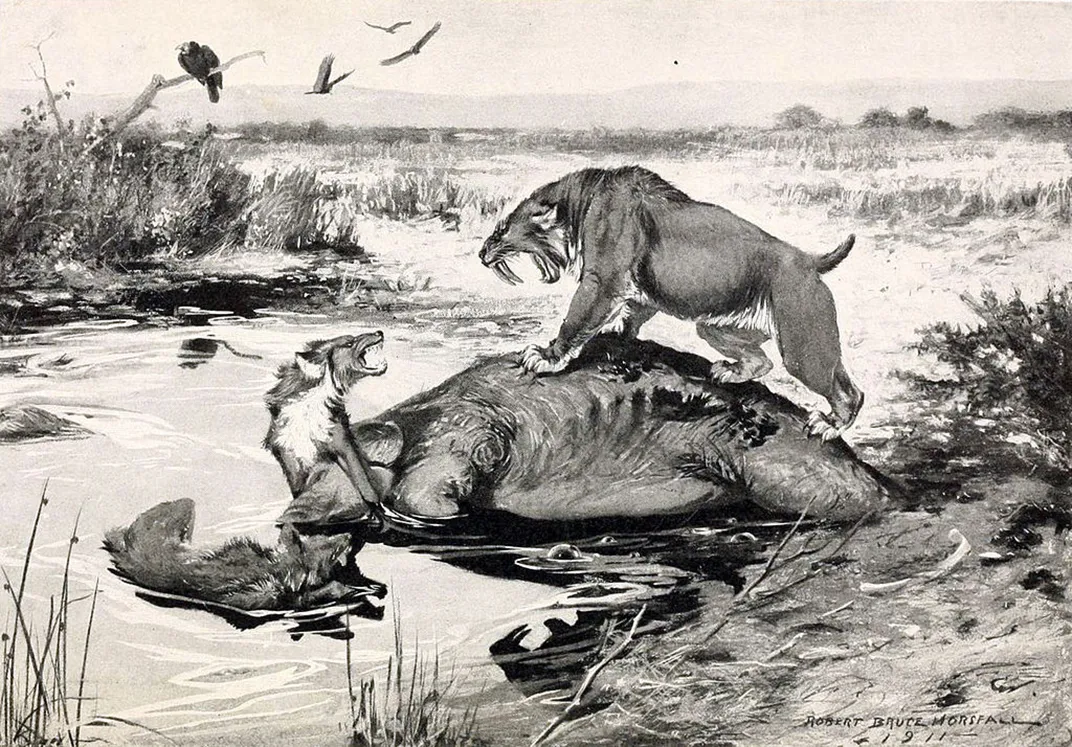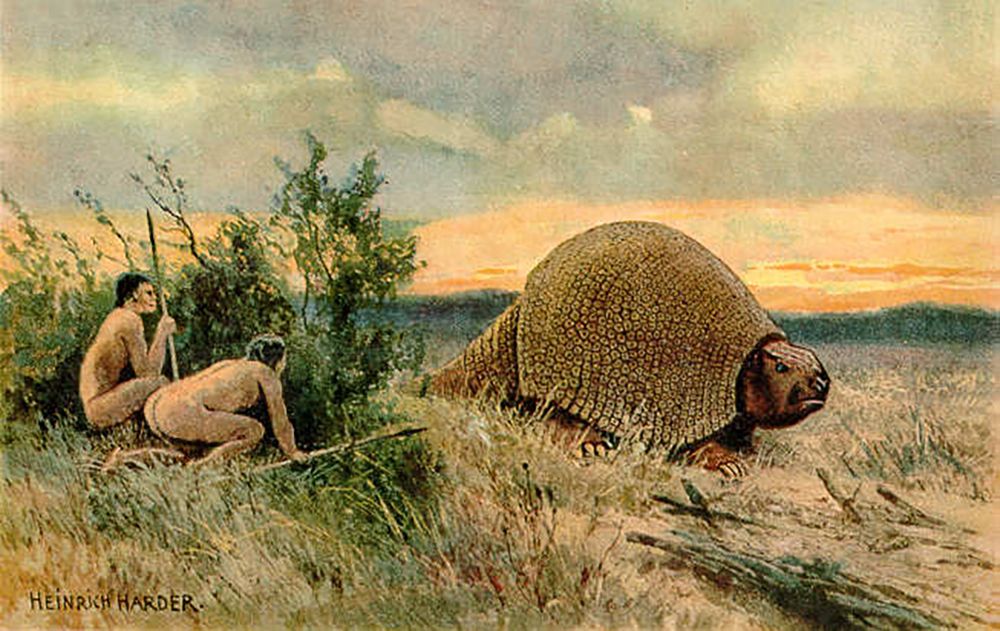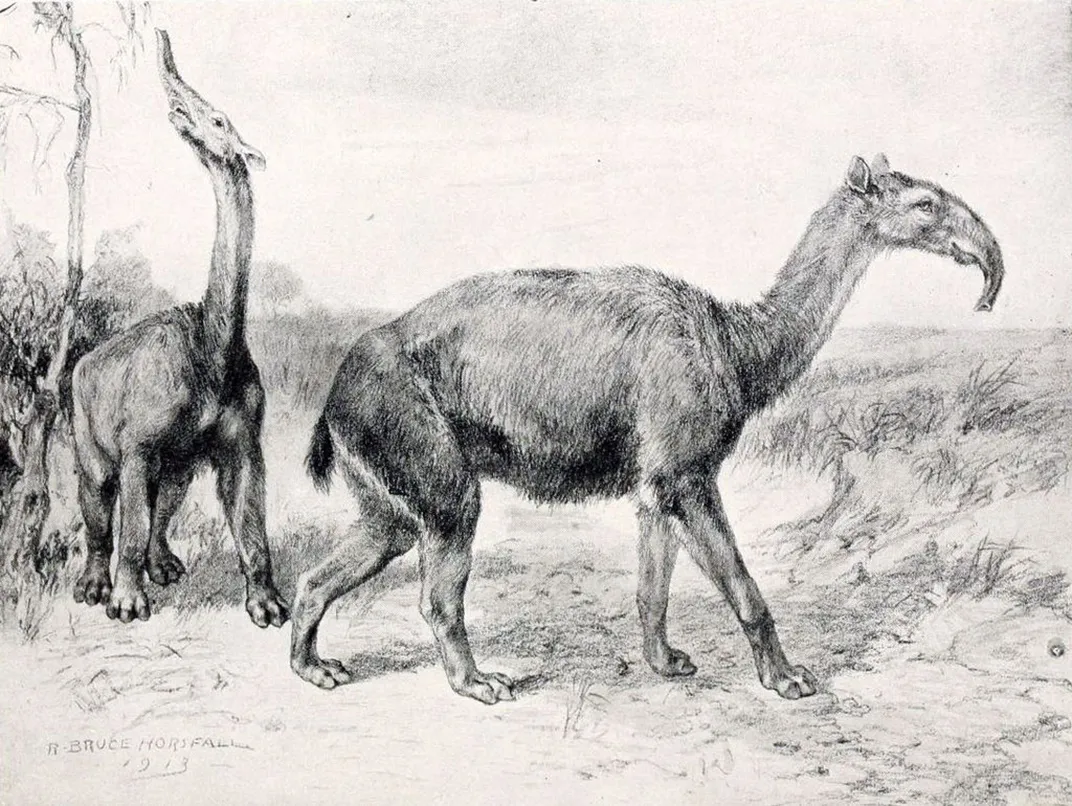Are Humans to Blame for the Disappearance of Earth’s Fantastic Beasts?
100,000 years ago, giant sloths, wombats and cave hyenas roamed the world. What drove them all extinct?
:focal(530x245:531x246)/https://tf-cmsv2-smithsonianmag-media.s3.amazonaws.com/filer/0f/f7/0ff7a1ac-c032-4eea-818e-c13f6e4e9bef/ice_age_fauna_of_northern_spain_-_mauricio_anton.jpg)
Turn the clock back 1.8 million years, and the world was full of fantastic beasts: In North America, lions, dire wolves and giant sloths prowled the land. South America boasted camel-like creatures and giant 4,500-pound bears. Eurasia had rhinoceroses and cave hyenas, while Australia teemed with giant wombats and 7-foot-tall flightless birds. Across all those continents and many islands were massive, long-nosed creatures that included the notorious woolly mammoths and mastodons.
Today we have less than half of the species known as megafauna—an exclusive club whose members weigh at least 97 pounds when fully grown—on all continents but Africa. Where did these giants all go? In the past 50 years, archaeologists have started to come to a damning conclusion: Perhaps they would still be here if humans hadn’t arrived on the scene.
First proposed in 1966 by paleontologist Paul Martin, this “overkill hypothesis” stated that the arrival of modern humans in each new part of the world brought with it the extinction of all those huge animals, whether through hunting them or outcompeting them. The hypothesis paints humans as a potent force of destruction and was highly controversial when Martin first proposed it. But over time it gained traction—though never full consensus—in the archaeological community.
Today, some archaeologists continue to fight back. For many of these Pleistocene extinctions, humans probably aren’t to blame, says archaeologist Ben Marwick. The key to his argument is timing: Marwick and other researchers recently found human artifacts in the Madjedbebe rock shelter in northern Australian that indicate humans came to the island 65,000 years ago, 10,000 years earlier than previously believed. That’s critical, because Australian megafauna didn’t start going extinct until sometime between 60,000 and 40,000 years ago.
The new data “puts people on the landscape well before megafauna started suffering population stress and showing signs of extinction,” Markwick says. “It’s like the alibi for humans: It absolves them of central responsibility.”

Marwick believes his team’s find in Australia may be close to a deathblow for the hypothesis. “In archaeology we rarely have such decisive finds that shift the argument from an ongoing debate to a fact, but my feeling is that this could be one of those moments,” he says. Indeed, recent finds have threatened to upend the conventional timeline of human migration. Marwick pointed to a controversial study from April that suggests humans arrived in North America 100,000 years earlier than previously believed. “It looks as if the whole global debate of megafauna extinction is getting a simultaneous revision,” he says.
If that’s true, the consequences would go beyond the scientific. “If it turns out we didn’t kill the megafauna,” says Marwick, “that might suggest our relationship is more one of being just another species on the landscape, rather than a total domination and inflicting environmental violence.”
But for two scientists, the same data can tell vastly different stories. Geologist and paleontologist Gifford Miller of University of Colorado at Boulder thinks Marwick’s study proves the exact opposite of what Marwick claims. “One of the previous arguments against a human role in the Australian megafaunal extinction was that humans first appeared there 50,000 years ago and animals were gone almost immediately after, which doesn’t given them enough time to build a population size sufficient to have any kind of impact," he says.
Marwick’s data, he says, helps solve this discrepancy. The earlier arrival date gives humans time to grow in number over generations, spreading across the landscape, eating whatever they came across and transforming the environment. “It’s undeniable that humans are preying on some of these large animals,” says Miller, “and undeniably something happens to the ecosystem structure and function at about the same time.”
Miller knows the signs of human hunting better than most. He has spent years studying the burnt remains of eggs laid by Australian thunder birds (Genyornis newtoni), giant flightless avians that went extinct approximately 47,000 years ago. In 2015 Miller and others published a paper in Nature Communications arguing the burn patterns on these eggshells, which have been found in more than 200 hearth sites across Australia, were different than what would be seen from natural wildfires.
“You can’t make a firm statement, but I think the smart money is [the megafauna] would still be around if humans hadn’t arrived,” he says.

One counterargument to the overkill hypothesis is that ancient climate change killed off all those huge beasts. Scientists on this side of the fence argue that, depending on the continent, fluctuations in temperature and humidity spelled doom for the megafauna. Yet Miller, who has also studied climate change in Australia from the Quaternary period beginning 2.5 million years ago to today, finds that argument lacking.
“These are animals that have been living through the Quaternary, and it’s a rough time. In Australia, you go from extreme cold and dry during Ice Age periods and warmer and wetter conditions in interglacial times. And they’ve made it through 20 of these cycles.”
Archaeologist Todd Surovell tends to agree with Miller’s assessment, though he didn’t always. Surovell was a student under Martin, the father of the overkill hypothesis. Initially, he was skeptical. “The biggest hang up is the paucity of physical evidence. For me that was the case for a long time,” Surovell says. But when he started studying megafaunal extinction on a global scale, not just in North America, the patterns he saw astounded him. “Hunting these large mammals tracks global colonization perfectly,” he says. “Humans move to a new place, [megafauna] suffer extinction.”
Of course, the ecological and archaeological landscapes are vastly different between Australia and North America, where Surovell does most of his research. In Australia, there’s relatively little evidence of humans hunting or eating megafauna other than the eggshells Miller studied; scientists have found no definitive proof that humans caused the doom of dozens of other deceased species, including 25-foot-long lizards and 1,000-pound kangaroos. But in North America, there are dozens of sites that show human exploitation of mammoths for their meat and tusks, though those sites can sometimes be contentious in their own right.
“There are more than 70 mammoths that have been argued to have some cultural association [human markings or evidence of butchery],” Surovell says. “Of those, the archaeological community would accept 16 as definite.” Some argue that just because a spearhead was found in the same location as a mammoth, it doesn’t mean humans killed it; they could’ve just been scavenging its meat. And then there’s the fact that plenty of other species—from short-faced bears to Glyptodons, which were essentially 1-ton armadillos—but we have no evidence of humans hunting them.
That means humans didn’t play any role in driving these other giants extinct, Surovell clarifies. “I don’t know anything about hunting ground sloths, but I imagine a 16-year-old kid with a spear coming across one, is he going to ignore that? No,” he speculates.

While he’s considered the impacts of large carnivores like lions and saber-toothed cats, Surovell believes that the pressure humans put on the landscape forced those apex hunters to extinction. After all, humans aren’t just hunters; we’re ecosystem shapers. By changing the landscape and driving out predators, we may have had a far larger impact than even the deadliest non-human predators. For Miller, all the evidence of humankind’s ability to alter ecosystems provides irrefutable evidence of the overkill hypothesis.
But that doesn’t mean the debate is anywhere near settled.
Like climate change or human evolution, Miller says, the debate over whether humans are responsible for extinctions can be about values just as much as it is about data. “I’m not sure there’s any evidence that will convince people who don’t want humans to be responsible for such a big change,” Miller says. “They want to put it in terms of good and bad. There’s nothing to do with good and bad. It’s not that humans set out to exterminate things. They’re trying to feed their families the most efficient way they can.”
The idea that ancient hunter-gatherers dramatically altered their ecosystems doesn’t necessarily line up with the stereotypes people have, Surovell adds—which is all the more reason to find evidence for the hypothesis. “People like to think we don’t see major human environmental impacts until the Neolithic, with farming, but I think that’s absolutely not the case,” he says. “We see it from the very beginning of human existence on the planet. I think it speaks to our nature as animals, as ecological agents, as shapers of the environment.”
What all of them agree on is that the debate is far from being over, and people will continue hunting for evidence to prove and disprove the overkill hypothesis. Surovell believes it would take faunal evidence from a dozen early North American human sites to really solidify the hypothesis among North American archaeologists. But he does say this: “The best way to falsify overkill is to show animals went extinct before human arrival. For 50 years now we’ve been trying to falsify overkill and we’ve failed. That, to me, suggests it’s a pretty strong hypothesis.”
/https://tf-cmsv2-smithsonianmag-media.s3.amazonaws.com/accounts/headshot/lorraine.png)
/https://tf-cmsv2-smithsonianmag-media.s3.amazonaws.com/accounts/headshot/lorraine.png)